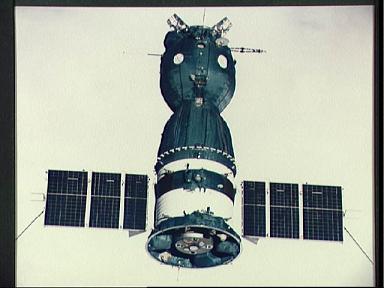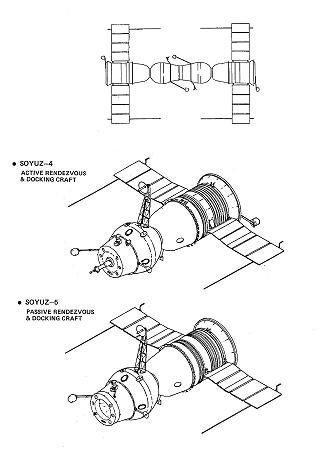Forty years ago, on January 16, 1969, two Russian spacecraft (Soyuz 4 and Soyuz 5) carried out the first docking between two manned spacecraft and transfer of crew between the craft.
The Soyuz 4/5 mission was a critical milestone for the future of manned space missions, the rendezvous and docking of manned spacecraft being essential for the development of space stations.
Soyuz 4 was launched on January 14, 1969, with cosmonaut Vladimir Shatalov on board. Soyuz 5 was launched one day later. Soyuz 5 had three cosmonauts on board: Boris Volynov, Alexei Yeliseyev, and Yevgeny Khrunov. During the mission, Soyuz 5 acted as the passive ship, while Soyuz 4 was the active chaser craft.
The two spacecraft docked at 0820 UT over the Soviet territory. The docking mechanism did not connect the pressurized modules of the Soyuz spacecraft and two of the cosmonauts on board Soyuz 5, Yevgeny Khrunov and Alexei Yeliseyev, performed EVAs in order to transfer to Soyuz 4.
Soyuz 4 and 5 undocked after three hours and thirty-five minutes.
Soyuz 4 fired its retro-rockets on January 17 and landed somewhere near Karaganda, in Kazakhstan.
Soyuz 5 had an eventful landing. After the retro-fire, the instrument module failed to separate from the descent module, and the landing could have been catastrophic due to the fact that the heat shield was not oriented properly.
However, the re-entry heat caused the propellant tanks in the instrument module to explode and the two modules eventually separated. The parachute had problems deploying properly and a failure of the soft-landing rockets occurred, so the landing was much harder than usual. Apparently, the landing shock was so great that Boris Volynov was thrown across the cabin and broke some of his front teeth.
Volynov landed far off course, in the Ural Mountains near Orenburg, in Russia. The event was kept secret and it eventually came to light in 1997, when an official history book mentioned the incident.
Forty years later, the Soyuz spacecraft is still the workhorse of the Russian space program, and continues to this day to serve as a transfer vehicle to and from the International Space Station (ISS), performing rendezvous and docking maneuvers on each mission.











 Subscribe to our RSS feed
Subscribe to our RSS feed











There are no comments.
Add A Comment